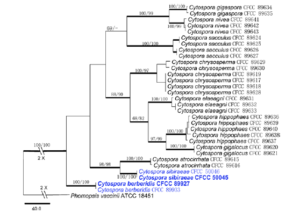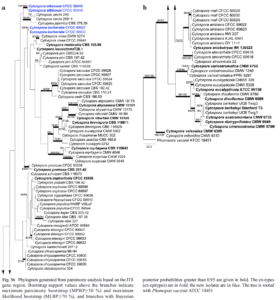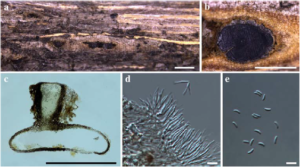Cytospora berberidis C.M. Tian, X.L. Fan & K.D.Hyde.
MycoBank MB811223, Facesoffungi number: FOF00491; Fig. 3
Etymology: berberis (Lat.), referring to Berberis dasystachya, on which the fungus was collected.
Holotype: BJFC-S681.
Pathogen on twigs and branches of Berberis dasystachya. Sexual morph Undetermined. Asexual morph Stromata immersed in bark. Conidiomata, erumpent through the surface of bark, discoid, nearly flat, with a solitary undivided locule. Conceptacle absent. Disc white to light brown, circular to ovoid, (0.32–)0.36–0.41(–0.47) mm (x=0.38 mm, n=20), with one ostiole per disc. Ostiole in the centre of the disc, at the same level as the disc surface, (12.1–)13.9–18.5(–21.7)mm (x=16.3 mm, n=20) diam. Locule uniloculate, (0.63–)0.69–0.87(–0.91) mm (x=0.78μm, n=20) diam. Conidiophores hyaline, unbranched or occasionally branched at the bases, (16.4–)17.5–25.5(–26.2) μm (x=21.7μm, n=20). Conidia hyaline, elongate-allantoid, aguttulate, aseptate, (5.8–)6–6.9(–7.1)×(1.8–)1.9–2.1(–2.2) μm (x in 6.5×2μm, n=50).
Culture characters: Colony white, flat, felty, texture uniform, conidiomata sparse, irregularly distributed.
Material examined: CHINA, Qinghai Province, Huzhu, Jiading, 36°56′12.62″ N, 102°30′11.85″ E, 2324 m asl., on twigs and branches of Berberis dasystachya Maximowicz (Berberidaceae), 15 August 2012, X.L. Fan (BJFC-S681, holotype); ex-type living culture, CFCC 89927. GenBank ITS: KP340985; LSU: KP340989; ACT: KP340997; RPB2: KP340993; ibid., living culture, CFCC 89933. GenBank ITS: KP340986; LSU: KP340990; ACT: KP340998; RPB2: KP340994.
Notes: Cytospora berberidis with a single locule, differs from most Cytospora species with multi-locules, including type species C. chrysosperma. The new species can be distinguished from C. pruinosa and C. atrocirrhata with single locules by the absence of conceptacles and size of conidia. Molecular analysis also confirms the novelty of the species which forms a single clade with high support (Figs. 1 and 2). This novel species represents the first record of Cytospora isolated from Berberis dasystachya.

Fig. 1 Phylogram generated from parsimony analysis based on the combined genes of ITS, nrLSU, RPB2 and ACT gene regions. Bootstrap support values above the branches indicate maximum parsimony bootstrap (MPBP≥50 %) and maximum likelihood bootstrap (MLBP≥ 70 %), and branches with Bayesian posterior probabilities greater than 0.95 are given in bold. The ex-types (ex-epitypes) are in bold, the new isolates are in blue. The tree is rooted with Phomopsis vaccinii ATCC 18451.

Fig. 2 Phylogram generated from parsimony analysis based on the ITS gene region. Bootstrap support values above the branches indicate maximum parsimony bootstrap (MPBP≥50 %) and maximum likelihood bootstrap (MLBP≥70 %), and branches with Bayesian posterior probabilities greater than 0.95 are given in bold. The ex-types (ex-epitypes) are in bold; the new isolates are in blue. The tree is rooted with Phomopsis vaccinii ATCC 18451.

Fig. 3 Cytospora berberidis (holotype) a Habit of conidiomata on a twig b Transverse sections through conidiomata c Longitudinal sections through conidiomata d Conidiophores e Conidia. Scale bars: a-c=0.5 mm; d–e=10μm.
